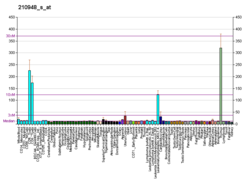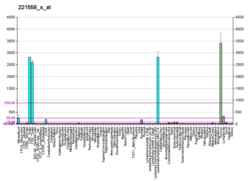Lymphoid enhancer-binding factor 1
| LEF1 | |||||||||||||||||||||||||||||||||||||||||||||||||||
|---|---|---|---|---|---|---|---|---|---|---|---|---|---|---|---|---|---|---|---|---|---|---|---|---|---|---|---|---|---|---|---|---|---|---|---|---|---|---|---|---|---|---|---|---|---|---|---|---|---|---|---|
 | |||||||||||||||||||||||||||||||||||||||||||||||||||
| |||||||||||||||||||||||||||||||||||||||||||||||||||
| Identifiers | |||||||||||||||||||||||||||||||||||||||||||||||||||
| Aliases | LEF1, LEF-1, TCF10, TCF1ALPHA, TCF7L3, lymphoid enhancer binding factor 1 | ||||||||||||||||||||||||||||||||||||||||||||||||||
| External IDs | MGI: 96770; HomoloGene: 7813; GeneCards: LEF1; OMA:LEF1 - orthologs | ||||||||||||||||||||||||||||||||||||||||||||||||||
| |||||||||||||||||||||||||||||||||||||||||||||||||||
| |||||||||||||||||||||||||||||||||||||||||||||||||||
| |||||||||||||||||||||||||||||||||||||||||||||||||||
| |||||||||||||||||||||||||||||||||||||||||||||||||||
| |||||||||||||||||||||||||||||||||||||||||||||||||||
| Wikidata | |||||||||||||||||||||||||||||||||||||||||||||||||||
| |||||||||||||||||||||||||||||||||||||||||||||||||||
Lymphoid enhancer-binding factor 1 (LEF1) is a protein that in humans is encoded by the LEF1 gene.[5] It is a member of T cell factor/lymphoid enhancer factor (TCF/LEF) family.
Function
Lymphoid enhancer-binding factor-1 (LEF1) is a 48-kD nuclear protein that is expressed in pre-B and T cells. It binds to a functionally important site in the T-cell receptor-alpha (TCRA) enhancer and confers maximal enhancer activity. LEF1 belongs to a family of regulatory proteins that share homology with high mobility group protein-1 (HMG1).[6]
Clinical significance
LEF1 is highly overexpressed and associated with disease progression and poor prognosis in B-cell chronic lymphocytic leukemia[7] and other kinds of malignancies like colorectal cancer.[8] It is also a promising potential drug target.[9]
Interactions
Lymphoid enhancer-binding factor 1 has been shown to interact with:
- ALX4,[10]
- AML-1,[11]
- Catenin beta-1/β-catenin/CTNNB1,[12][13][14][15] including transgenically,[16]
- EP300,[17]
- MITF[18]
- PIAS4,[19]
- SMAD2,[15] and
- SMAD3.[15]
References
- ^ a b c GRCh38: Ensembl release 89: ENSG00000138795 – Ensembl, May 2017
- ^ a b c GRCm38: Ensembl release 89: ENSMUSG00000027985 – Ensembl, May 2017
- ^ "Human PubMed Reference:". National Center for Biotechnology Information, U.S. National Library of Medicine.
- ^ "Mouse PubMed Reference:". National Center for Biotechnology Information, U.S. National Library of Medicine.
- ^ Milatovich A, Travis A, Grosschedl R, Francke U (December 1991). "Gene for lymphoid enhancer-binding factor 1 (LEF1) mapped to human chromosome 4 (q23-q25) and mouse chromosome 3 near Egf". Genomics. 11 (4): 1040–1048. doi:10.1016/0888-7543(91)90030-I. PMID 1783375.
- ^ "Entrez Gene: LEF1 lymphoid enhancer-binding factor 1".
- ^ Erdfelder F, Hertweck M, Filipovich A, Uhrmacher S, Kreuzer KA (January 2010). "High lymphoid enhancer-binding factor-1 expression is associated with disease progression and poor prognosis in chronic lymphocytic leukemia". Hematology Reports. 2 (1): e3. doi:10.4081/hr.2010.e3. PMC 3222268. PMID 22184516.
- ^ Eskandari E, Mahjoubi F, Motalebzadeh J (December 2018). "An integrated study on TFs and miRNAs in colorectal cancer metastasis and evaluation of three co-regulated candidate genes as prognostic markers". Gene. 679: 150–159. doi:10.1016/j.gene.2018.09.003. PMID 30193961. S2CID 52172531.
- ^ Gandhirajan RK, Staib PA, Minke K, Gehrke I, Plickert G, Schlösser A, et al. (April 2010). "Small molecule inhibitors of Wnt/beta-catenin/lef-1 signaling induces apoptosis in chronic lymphocytic leukemia cells in vitro and in vivo". Neoplasia. 12 (4): 326–335. doi:10.1593/neo.91972. PMC 2847740. PMID 20360943.
- ^ Boras K, Hamel PA (January 2002). "Alx4 binding to LEF-1 regulates N-CAM promoter activity". The Journal of Biological Chemistry. 277 (2): 1120–1127. doi:10.1074/jbc.M109912200. PMID 11696550.
- ^ Lutterbach B, Westendorf JJ, Linggi B, Isaac S, Seto E, Hiebert SW (January 2000). "A mechanism of repression by acute myeloid leukemia-1, the target of multiple chromosomal translocations in acute leukemia". The Journal of Biological Chemistry. 275 (1): 651–656. doi:10.1074/jbc.275.1.651. PMID 10617663.
- ^ Edlund S, Lee SY, Grimsby S, Zhang S, Aspenström P, Heldin CH, Landström M (February 2005). "Interaction between Smad7 and beta-catenin: importance for transforming growth factor beta-induced apoptosis". Molecular and Cellular Biology. 25 (4): 1475–1488. doi:10.1128/MCB.25.4.1475-1488.2005. PMC 548008. PMID 15684397.
- ^ Grueneberg DA, Pablo L, Hu KQ, August P, Weng Z, Papkoff J (June 2003). "A functional screen in human cells identifies UBF2 as an RNA polymerase II transcription factor that enhances the beta-catenin signaling pathway". Molecular and Cellular Biology. 23 (11): 3936–3950. doi:10.1128/MCB.23.11.3936-3950.2003. PMC 155208. PMID 12748295.
- ^ Behrens J, von Kries JP, Kühl M, Bruhn L, Wedlich D, Grosschedl R, Birchmeier W (August 1996). "Functional interaction of beta-catenin with the transcription factor LEF-1". Nature. 382 (6592): 638–642. Bibcode:1996Natur.382..638B. doi:10.1038/382638a0. PMID 8757136. S2CID 4369341.
- ^ a b c Labbé E, Letamendia A, Attisano L (July 2000). "Association of Smads with lymphoid enhancer binding factor 1/T cell-specific factor mediates cooperative signaling by the transforming growth factor-beta and wnt pathways". Proceedings of the National Academy of Sciences of the United States of America. 97 (15): 8358–8363. Bibcode:2000PNAS...97.8358L. doi:10.1073/pnas.150152697. PMC 26952. PMID 10890911.
- ^ Barolo S, Posakony JW (May 2002). "Three habits of highly effective signaling pathways: principles of transcriptional control by developmental cell signaling". Genes & Development. 16 (10). Cold Spring Harbor Laboratory Press & The Genetics Society: 1167–1181. doi:10.1101/gad.976502. PMID 12023297. S2CID 14376483. p. 1170:
In ... zebrafish, reporter transgenes containing the TOPFLASH promoter are expressed in certain Wnt-responsive cell types (...Dorsky et al. 2002).
- ^ Hecht A, Stemmler MP (February 2003). "Identification of a promoter-specific transcriptional activation domain at the C terminus of the Wnt effector protein T-cell factor 4". The Journal of Biological Chemistry. 278 (6): 3776–3785. doi:10.1074/jbc.M210081200. PMID 12446687.
- ^ Yasumoto K, Takeda K, Saito H, Watanabe K, Takahashi K, Shibahara S (June 2002). "Microphthalmia-associated transcription factor interacts with LEF-1, a mediator of Wnt signaling". The EMBO Journal. 21 (11): 2703–2714. doi:10.1093/emboj/21.11.2703. PMC 126018. PMID 12032083.
- ^ Sachdev S, Bruhn L, Sieber H, Pichler A, Melchior F, Grosschedl R (December 2001). "PIASy, a nuclear matrix-associated SUMO E3 ligase, represses LEF1 activity by sequestration into nuclear bodies". Genes & Development. 15 (23): 3088–3103. doi:10.1101/gad.944801. PMC 312834. PMID 11731474.
Further reading
- Waterman ML (2004). "Lymphoid enhancer factor/T cell factor expression in colorectal cancer". Cancer and Metastasis Reviews. 23 (1–2): 41–52. doi:10.1023/A:1025858928620. PMID 15000148. S2CID 20996511.
- Skokowa J, Welte K (June 2007). "LEF-1 is a decisive transcription factor in neutrophil granulopoiesis". Annals of the New York Academy of Sciences. 1106 (1): 143–151. Bibcode:2007NYASA1106..143S. doi:10.1196/annals.1392.012. PMID 17360796. S2CID 30579011.
- Travis A, Amsterdam A, Belanger C, Grosschedl R (May 1991). "LEF-1, a gene encoding a lymphoid-specific protein with an HMG domain, regulates T-cell receptor alpha enhancer function [corrected]". Genes & Development. 5 (5): 880–894. doi:10.1101/gad.5.5.880. PMID 1827423.
- van de Wetering M, Oosterwegel M, Dooijes D, Clevers H (January 1991). "Identification and cloning of TCF-1, a T lymphocyte-specific transcription factor containing a sequence-specific HMG box". The EMBO Journal. 10 (1): 123–132. doi:10.1002/j.1460-2075.1991.tb07928.x. PMC 452620. PMID 1989880.
- Waterman ML, Fischer WH, Jones KA (April 1991). "A thymus-specific member of the HMG protein family regulates the human T cell receptor C alpha enhancer". Genes & Development. 5 (4): 656–669. doi:10.1101/gad.5.4.656. PMID 2010090.
- Zhou P, Byrne C, Jacobs J, Fuchs E (March 1995). "Lymphoid enhancer factor 1 directs hair follicle patterning and epithelial cell fate". Genes & Development. 9 (6): 700–713. doi:10.1101/gad.9.6.700. PMID 7537238.
- Maruyama K, Sugano S (January 1994). "Oligo-capping: a simple method to replace the cap structure of eukaryotic mRNAs with oligoribonucleotides". Gene. 138 (1–2): 171–174. doi:10.1016/0378-1119(94)90802-8. PMID 8125298.
- Prieve MG, Guttridge KL, Munguia JE, Waterman ML (March 1996). "The nuclear localization signal of lymphoid enhancer factor-1 is recognized by two differentially expressed Srp1-nuclear localization sequence receptor proteins". The Journal of Biological Chemistry. 271 (13): 7654–7658. doi:10.1074/jbc.271.13.7654. PMID 8631802.
- Behrens J, von Kries JP, Kühl M, Bruhn L, Wedlich D, Grosschedl R, Birchmeier W (August 1996). "Functional interaction of beta-catenin with the transcription factor LEF-1". Nature. 382 (6592): 638–642. Bibcode:1996Natur.382..638B. doi:10.1038/382638a0. PMID 8757136. S2CID 4369341.
- Bagga R, Emerson BM (March 1997). "An HMG I/Y-containing repressor complex and supercoiled DNA topology are critical for long-range enhancer-dependent transcription in vitro". Genes & Development. 11 (5): 629–639. doi:10.1101/gad.11.5.629. PMID 9119227.
- Bruhn L, Munnerlyn A, Grosschedl R (March 1997). "ALY, a context-dependent coactivator of LEF-1 and AML-1, is required for TCRalpha enhancer function". Genes & Development. 11 (5): 640–653. doi:10.1101/gad.11.5.640. PMID 9119228.
- Brannon M, Gomperts M, Sumoy L, Moon RT, Kimelman D (September 1997). "A beta-catenin/XTcf-3 complex binds to the siamois promoter to regulate dorsal axis specification in Xenopus". Genes & Development. 11 (18): 2359–2370. doi:10.1101/gad.11.18.2359. PMC 316518. PMID 9308964.
- Suzuki Y, Yoshitomo-Nakagawa K, Maruyama K, Suyama A, Sugano S (October 1997). "Construction and characterization of a full length-enriched and a 5'-end-enriched cDNA library". Gene. 200 (1–2): 149–156. doi:10.1016/S0378-1119(97)00411-3. PMID 9373149.
- Korinek V, Barker N, Willert K, Molenaar M, Roose J, Wagenaar G, et al. (March 1998). "Two members of the Tcf family implicated in Wnt/beta-catenin signaling during embryogenesis in the mouse". Molecular and Cellular Biology. 18 (3): 1248–1256. doi:10.1128/MCB.18.3.1248. PMC 108837. PMID 9488439.
- Prieve MG, Guttridge KL, Munguia J, Waterman ML (August 1998). "Differential importin-alpha recognition and nuclear transport by nuclear localization signals within the high-mobility-group DNA binding domains of lymphoid enhancer factor 1 and T-cell factor 1". Molecular and Cellular Biology. 18 (8): 4819–4832. doi:10.1128/MCB.18.8.4819. PMC 109067. PMID 9671491.
- Levanon D, Goldstein RE, Bernstein Y, Tang H, Goldenberg D, Stifani S, et al. (September 1998). "Transcriptional repression by AML1 and LEF-1 is mediated by the TLE/Groucho corepressors". Proceedings of the National Academy of Sciences of the United States of America. 95 (20): 11590–11595. Bibcode:1998PNAS...9511590L. doi:10.1073/pnas.95.20.11590. PMC 21685. PMID 9751710.
- Hovanes K, Li TW, Waterman ML (May 2000). "The human LEF-1 gene contains a promoter preferentially active in lymphocytes and encodes multiple isoforms derived from alternative splicing". Nucleic Acids Research. 28 (9): 1994–2003. doi:10.1093/nar/28.9.1994. PMC 103301. PMID 10756202.
- Labbé E, Letamendia A, Attisano L (July 2000). "Association of Smads with lymphoid enhancer binding factor 1/T cell-specific factor mediates cooperative signaling by the transforming growth factor-beta and wnt pathways". Proceedings of the National Academy of Sciences of the United States of America. 97 (15): 8358–8363. Bibcode:2000PNAS...97.8358L. doi:10.1073/pnas.150152697. PMC 26952. PMID 10890911.
- Brantjes H, Roose J, van De Wetering M, Clevers H (April 2001). "All Tcf HMG box transcription factors interact with Groucho-related co-repressors". Nucleic Acids Research. 29 (7): 1410–1419. doi:10.1093/nar/29.7.1410. PMC 31284. PMID 11266540.
External links
- LEF1+protein,+human at the U.S. National Library of Medicine Medical Subject Headings (MeSH)
This article incorporates text from the United States National Library of Medicine, which is in the public domain.
- v
- t
- e
-
 2lef: LEF1 HMG DOMAIN (FROM MOUSE), COMPLEXED WITH DNA (15BP), NMR, 12 STRUCTURES
2lef: LEF1 HMG DOMAIN (FROM MOUSE), COMPLEXED WITH DNA (15BP), NMR, 12 STRUCTURES





















